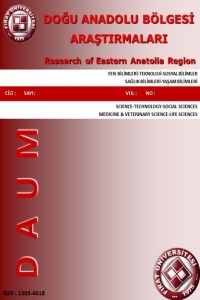OKSİDATİF STRESE MARUZ BIRAKILMIŞ RATLARA VERİLEN BİOCHANİN A‘NIN SERUMDAKİ BAZI BİYOKİMYASAL PARAMETRELER ÜZERİNE ETKİSİ
H2O2, MDA, Katalaz, Glutatyon Peroksidaz, GSH, Biochanin A, Serum, Sıçan
___
- 1. Machlin, L. J., Bendich, A., Maestro, R. F., 1980, An Approach to Free Radicals in Medicine and Biology, Acta Physiol. Scand. Suppl., 492, 153-168.
- 2. Fabes J., 1987, Free Radical Tissue Damage, Protective Role of Antioxidant Nutrients, 1, 441-445.
- 3. Yu, P.B., 1994, Cellular Defenses Against Damage From Reactive Oxygen Species, Physiol. Rev., 74, 1.
- 4. Dergel, R., 1992, Lipid Peroxsitation a Common Pathogenetic Mechanism, Exp. Toxicol Pathol., 44 (4), 169-181.
- 5. Hollmann, P.C.H., Batan, M.B., 1997, Absorption, metabolism and healht effect of dietary flavonoids in man, Biomed. Pharmacotherapy, 51 , 305-310.
- 6. Formica, J.V., Regelson, W., 1995, Review of the biology of quercetin and related bioflavo-noids, Food Chem. Toxicol 33: 1061-1080.
- 7. Hanasaki, Y., Owaga, S., Fukui, S., 1994, The correelation betwen active oksigen scavenging and antioxidative effects of flavonoids, Free Radic Biol Med; 16: 845-50.
- 8. Takahama, U., 1985, Inhibition of lipoxygenase-dependent peroxitation by quercetin: mecha-nisms of antioxidative function, Phytochemistry; 24: 1443-6.
- 9. Majid, S., Khanduja, K.L., Gandhi, R.K., Kapur, S., Sharma, R.R., 1991, Influence of ellagik asit on antioxidant defense system andlipid perok-sitation in mice, Biochem Pharmacol; 42: 1441–5.
- 10. a. Harper, A., Kerr, D.J., Gescher, A., Chipman, J.K., 1999.Antioxidant effects of isoflavonoids and lignans, and protection against DNA oxida-tion. Free Radical Res. 31, 149–160. b. Ruiz-Larrea, M.B., Mohan, A.R., Paganga, G., Miller, N.J.,Bowell, G.P., Rice-Evance, C., 1999. Anti-oxidant activity of phytoestrogenic isoflavones. Free Radical Res. 26, 63–70.
- 11. Placer, Z.A., Cushman, L.L., Johnson, B.C., 1966, Estimation of product of lipid peroxidation (malonyl dialdehyde) in biochemical systems, Anal Biochem; 16: 359–364.
- 12. Goth, L., 1991, A simple method for determi-nation of serum catalase activity and revision of reference range, Clin Chim Acta; 196: 143-152.
- 13. Lawrence, R.A., Burk, R.R., 1976, Glutathione peroxidase activity in selenium-deficient rat liver, Bioch Bioph Res Commun., 71(4): 952-958.
- 14. Lowry, O.O., Rosebrough, N.J., Farr, A.L., Ran-dall, R.I., 1951, Protein measurement with folin phenol reagent, J Biol Chem, 193: 265-275.
- 15. Sedlak, J., Lindsay, R.H., 1968, Estimation of total, protein-bound, and nonprotein sulfhydryl groups in tissue with Ellman’s reagent, Anal. Biochem., 25:192-205
- 16. a.Wei, H., Bowen, R., Cai, Q., Barnes, S., Wang, Y., 1995. Antioxidant and antipromoti-onal effects of the soybean isoflavone genistein. Proc. Soc. Exp. Biol. Med. 208, 124–130. b. Cai, Q., Wei, H., 1996. Effect of dietary genistein on antioxidant enzyme activities in SENCAR mice. Nutr. Cancer 25,1–7.
- 17. Rodrigo, R., Rivera, G., Orellana, M., Araya, J., Bosco, C., 2002, Rat kidney antioxidant respon-se to long-term exposure to flavonol rich red wine, Life Sci., 71:2881-289.
- 18. Molina, M.F., Sanchez-Reus, I., Iglesias, I., Be-nedi, J., 2003, Quercetin, a flavonoid antioxi-dant, prevent and protects against ethanol-induced oxidative stres in mouse liver, Biol Pharm Bull, 26:1398-140.
- 19. Appelt, L.C., Reicks, M.M., 1999. Soy induces phase II enzymes but does not inhibit dimethyl-benz[a]anthracene-induced carcinogenesis in fe-male rats. J. Nutr. 129, 1820–1826.
- ISSN: 1303-4618
- Başlangıç: 2002
- Yayıncı: Fırat Üniversitesi
ÖRGÜTSEL ÇATIŞMANIN VE PERFORMANS DEĞERLEMENİN İŞGÖREN PERFORMANSINA ETKİLERİ
YUKARI FIRAT BÖLGESİ’NDE 2006 YILI YÜZEY ARAŞTIRMALARINDA TESBİT EDİLEN İKİ YENİ URARTU KAYA MEZARI
BİR KÖPEKTE BİLATERAL KİSTİK DİRSEK HİGROMASI OLGUSU VE SAĞALTIMI
Ali Said DURMUŞ, Aydin SAĞLIYAN
SPOR HİZMETLERİNİN GENEL EKONOMİ ÇERÇEVESİNDE GÖRÜNÜMÜ
Cemal GÜNDOĞDU, SEBAHATTİN DEVECİOĞLU
MENTAL KONSANTRASYON ÇALIŞMALARININ BİLEK GÜREŞİ ERKEK SPORCULARININ REAKSİYON ZAMANLARINA ETKİSİ
Yonca BİÇER, Hasan Aykut AYSAN
GÜNÜMÜZDE TÜRKİYE’DE SİNEMA FİLMLERİYLE TELEVİZYON DİZİLERİNDE KADINLAR VE TÖRE
HAZAR GÖLÜ SU KALİTESİNİN ZAMANLA DEĞİŞİMİ
Ayhan ÜNLÜ, Fatih ÇOBAN, Müslün Sara TUNÇ
BÂKÎ’NİN KASİDELERİNDEKİ REDİFLERDEN HAREKETLE BÂKÎ VE DÖNEMİNE BİR BAKIŞ
